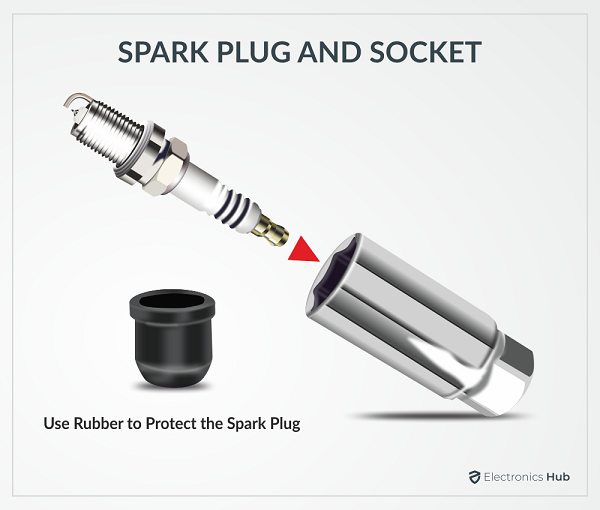Ignition System in Cars
When you insert the key into the car and turn it to ignition (or press the electronic start button in most modern cars), the ECU of the car makes an electrical connection between the battery and the primary ignition coil. As we crank the engine, the pulsating voltage in the primary coil induces a voltage in the secondary coil, which can be as high 20,000V – 25,000V (or more). This high voltage is then applied to the spark plug, which then creates an arc in the air gap, thus igniting the air – fuel mixture. This causes a high pressure in the cylinder and as a result it pushes the piston down and starting the engine. Once the engine is running, the ignition system repeats this process of converting low voltage from battery to high voltage, sending it to spark plug and the arc igniting the fuel as directed by the ECU.
A Brief Note on Spark Plugs
It is clear from the above discussion that the ignition system is an important part of all internal combustion engines. While there are many parts in a typical ignition system, let us focus on the Spark Plug. A Spark Plug consists of a main central electrode surrounded by a ceramic insulator. A portion of this insulator is covered with a metal shell with threads that allow it to be screwed into the cylinder head. There is another electrode, which is the ground electrode. It is part of the metal shell and gets connected to the metal frame of the car (which acts as the negative terminal). There is a small gap between the central electrode and the ground electrode known as the air gap. When we create a potential difference (by applying the high voltage from the ignition coil to the central electrode) between the two electrodes, the gas molecules in the air gap are ionized and forms a charge region. This charge region bridges the air gap between the electrodes. With sufficient electrical energy, current flows the charge region and the gas molecules get super-hot and create a plasma (that looks like an arc). This high temperature of the plasma is responsible for igniting the fuel-air mixture. An important point about the design of the spark plug is that the metal shell not only acts as a ground terminal but also provides the structural strength to bear the torque while tightening or removing the plug from the cylinder. As a result, the metal shell also consists of the hex nut, just above the threads. We can use a wrench or ratchet with correct socket size to insert or remove the spark plug.
Spark Plug Size
International Organization for Standardization (ISO) and Society of Automotive Engineers (SAE) have respective standards for the length, hex size, thread diameter and pitch of spark plugs. When we say “spark plug size”, we usually mean the diameter of the threads of the spark plug. The two most common spark plug sizes in modern motorcycles and small cars are 14mm and 18mm. Some automobile manufacturers also use 16mm high-thread count spark plugs and 12mm long-reach spark plugs.
Spark Plug Socket Size Chart
A Spark Plug Socket Size is dependent on the size of the hex nut on the metal shell. The following table shows the Spark Plug Socket Size Chart for some of the most commonly used spark plugs.
Removing and Installing Spark Plug
A good spark plug will not only burn fuel efficiently (without any wastage) but also helps the engine in running for a long time. Hence, it is essential to inspect, clean and if necessary, replace spark plugs in your cars and motorbikes. Most automobile user manuals (or service manuals) specify when to inspect/clean/replace spark plugs. The good thing about spark plugs is that they are relatively simple components to work with and you can remove and install them without the need for going to a work shop. If you plan to take out the spark plug yourself, then it is essential that you have the proper tools and also take necessary precautions.
Speaking of tools, you need a ratchet, a spark plug socket and a universal joint. Here, selecting the right spark plug socket size is very important. In case of a wrong socket, it will slip off the plug and can break the insulator (porcelain). Once you have the right tools, make sure that the engine is off for a significant period so that it is properly cool. Do not work on recently shut off engines. Remove the spark plug wire first. Then, using the combination of ratchet, spark plug socket and if necessary, an extension, unscrew the spark plug and while you take out the socket, the spark plug will come with it. Once the spark plug is out, inspect and clean it. Before installing the spark plug back into the cylinder, use a flash light and see whether the spark plug seat on the cylinder is clean or not. Now, seat the spark plug and screw it with hand for a couple of turns. Then, you can use the ratchet and socket to tighten the spark plug. If you are complete newbie, then you can use a torque wrench.
Conclusion
Spark plugs are an important part of modern IC engines (gasoline/petrol). A healthy spark plug will help the engine burn fuel more efficiently. So, frequent all automobile manufacturers recommend regular inspection of spark plugs. You can easily remove-inspect-clean-install spark plugs on your own, provided you have the right set of tools. And an important tool is the Spark Plug Socket. In this guide, we saw some popular spark plug socket sizes and also the procedure to remove and install a spark plug. Comment * Name * Email * Website
Δ






![]()